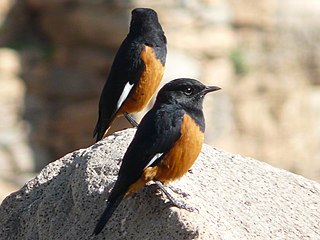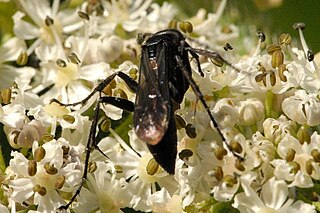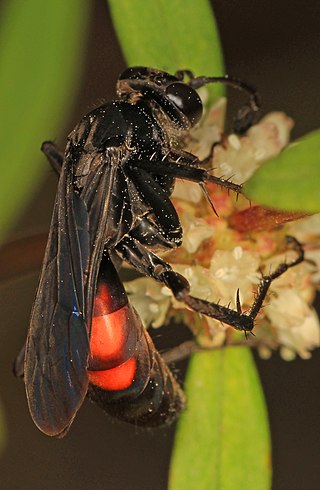
The rufous motmot is a near-passerine bird in the family Momotidae. It is found from northeastern Honduras south to western Ecuador, northern Bolivia, and western Brazil.

The rufous flycatcher is a bird species in the family Tyrannidae. It is endemic to Peru. Its natural habitats are subtropical or tropical moist lowland forests and subtropical or tropical dry shrubland. It was formerly classified as a species of least concern by the IUCN. But new research has shown it to be much rarer than it was believed. Consequently, it is uplisted to endangered in 2008.

The white-winged cliff chat is a species of passerine bird in the Old World flycatcher family Muscicapidae. It is found in rocky wooded gorges, among boulders and in road cuttings within the Ethiopian Highlands.

Anoplius is a genus of spider wasps in the family Pompilidae called the blue-black spider wasps. It is one of two genera within the tribe Anopliini of subfamily Pompilinae.

Anoplius nigerrimus is a species of spider wasp, or pompilid, and is the type species of the genus Anoplius.

Anoplius viaticus, commonly known as the black-banded spider wasp, is a species of spider wasp. These wasps are known as spider wasps because the females capture spiders to provide their offspring with food. The paralysed spider is cached in a burrow, the wasp lays an egg on it, and when this hatches, the developing wasp larva consumes the spider. This species is found in sandy heathland across most of Europe.

Anoplius americanus is a species of blue-black spider wasp which is widely distributed in the New World.
Ceutorhynchus semirufus is a species of minute seed weevil in the family Curculionidae. It is found in North America.
Anoplius virginiensis is a species of spider wasp in the family Pompilidae.
Phyllotrox is a genus of true weevils in the beetle family Curculionidae. There are at least 60 described species in Phyllotrox.
Anoplius illinoensis is a species of spider wasp in the family Pompilidae.

Anoplius subcylindricus is a species of spider wasp in the family Pompilidae.
Anoplius cleora is a species of spider wasp in the family Pompilidae.

Anoplius apiculatus is a species of spider wasp in the family Pompilidae.

Anoplius aethiops is a species of spider wasp in the family Pompilidae. It primarily lives in overgrown fields with fine-grained soil. It provisions its young with paralyzed Lycosidae spiders, especially those of the genus Hogna.

Anoplius atrox is a species of spider wasp in the family Pompilidae.

Myrmecocystus semirufus is a species of ant in the family Formicidae.
Anoplius carolinus is a species of spider wasp in the family Pompilidae.
Anoplius ithaca is a species of spider wasp in the family Pompilidae.

Ceropales bipunctata, the Two-Speckled Cuckoo Spider Wasp, is a species of diurnal, kleptoparasitic spider wasp in the family Pompilidae. It is an obligate kleptoparasite, meaning that it must rely on the captured provisions of other spider wasps and cannot capture its own. It is found on the Atlantic Coast of North America, north to New Brunswick, Canada. It feeds on nectar primarily from goldenrods, and also other common nectaring plants. It is known to lay an egg on the prey of other pompilids, including the two species Anoplius cleora and Anoplius aethiops. Eggs are laid in the book lung of the spider. These wasps also sometimes lay an egg on prey from spider-hunting wasps in the family Sphecidae.













